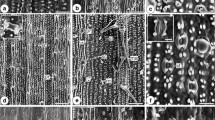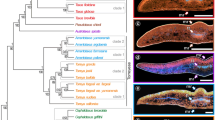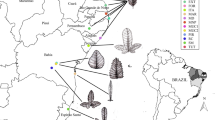Abstract
Setaria is numerically one of the largest and most taxonomically complex genera of the tribe Paniceae. The currently published phylogenies of Setaria are not fully resolved and some of the resulting clades reveal more geographical signals than morphological affinities. Therefore, external similarities among species of Setaria do not generally indicate relationships, morphology appears to be highly labile, and few inferences can be made regarding the taxonomy of the genus. In the present study we analyze the variation of the foliar anatomy through a cluster analysis including morphological characters used traditionally to delimit subgenera, sections and species. The aim of this study is to examine whether foliar anatomy, a source of evidence not previously utilized, provides useful information and can be predictive for recognizing homogenous groups of species within Setaria. The significance of the characters is evaluated to identify species groups. These groups were compared with infrageneric taxa and monophyletic clades established in previously published molecular phylogenies. Additionally, some foliar anatomical characters associated with the photosynthetic pathway are also discussed and compared with other members of the tribes Paniceae and Paspaleae.





Similar content being viewed by others
References
Aliscioni SS, Denham SS (2009) Atypical foliar anatomy related to Kranz syndrome in Paspalum inaequivalve and Paspalum microstachyum (Poaceae: Panicoideae: Paniceae). Flora 204:718–729. doi:10.1016/j.flora.2008.09.010
Aliscioni SS, Gomiz NE, Torretta JP, Pensiero JF (2011) Reproductive biology of Setaria magna Griseb. (Poaceae: Panicoideae: Paniceae). Pl Syst Evol 293:111–118. doi:10.1007/s00606-011-0428-0
Austin DF (2006) Fox-tail millets (Setaria: Poaceae), abandoned food in two hemispheres. Econ Bot 60:143–158. doi:10.1663/0013-0001(2006)60
Brown WV (1975) Variations in anatomy, associations, and origins of Kranz tissue. Amer J Bot 62:395–402. doi:10.2307/2442093
Brown WV (1977) The Kranz syndrome and its subtypes in grass systematics. Mem Torrey Bot Club 23:1–97
Carraro L, Patrignania G, Orsernigoa M (1991) Avena sativa and Setaria glauca: an anatomical and ultrastructural comparison between C3 and C4 plants. Caryologia 44:361–374. doi:10.1080/00087114.1991.10797203
Clayton WD, Renvoize SA (1986) Genera Graminum: grasses of the World. Her Majesty´s Stationery Office, London
Clayton WD, Vorontsova MS, Harman KT, Williamson T (2002) GrassBase-The online World Grass Flora. CVHW02. http://www.kew.org/data/grasses-db/cite.htm. Accessed 27 May 2015
D’Ambrogio de Argüeso AC (1986) Manual de Técnicas En Histología Vegetal. Hemisferio Sur, Buenos Aires
Davidse G, Pohl RW (1992) New taxa and nomenclatural combinations of Mesoamerican grasses (Poaceae). Novon 2:81–110. doi:0.2307/3391667
Davis JI (1983) Phenotypic plasticity and the selection of taxonomic characters in Puccinellia (Poaceae). Syst Bot 8:341–353. doi:10.2307/2418354
Dekker J (2003) The foxtail (Setaria) species-group. Weed Sci 51:641–656. doi:10.1614/P2002-IR
Douglas BJ, Thomas AG, Morrison IN, Maw MG (1985) The biology of Canadian weeds. 70. Setaria viridis (L.) P.Beauv. Canad J Pl Sci 65:669–690. doi:10.4141/cjps85-089
Doust AN, Penly AM, Jacobs SWL, Kellogg EA (2007) Congruence, conflict, and polyploidization shown by nuclear and chloroplast markers in the monophyletic “bristle clade” (Paniceae, Panicoideae, Poaceae). Syst Bot 32:531–544. doi:10.1600/036364407782250670
Ellis RP (1976) A procedure for standardizing comparative leaf anatomy in the Poaceae. I. The leaf-blade as viewed in transverse section. Bothalia 12:65–109. doi:10.4102/abc.v12i1.1382
Ellis RP (1977) Distribution of the Kranz syndrome in the southern African Eragrostoideae and Panicoideae according to bundle sheath anatomy and cytology. Agroplantae 9:73–110
Ellis RP (1979) A procedure for standardizing comparative leaf anatomy in the Poaceae. II. The epidermis as seen in surface view. Bothalia 12:641–671. doi:10.4102/abc.v12i4.1441
Fox WEI, Hatch S (1999) New combinations in Setaria (Poaceae: Paniceae). Sida 18:1037–1047
Gao MJ, Chen JJ (1988) Isozymic studies on the origin of cultivated foxtail millet. Acta Agron Sin 14:131–136
Hattersley PW, Watson L (1976) C4 grasses: an anatomical criterion for distinguishing between NADP-malic enzyme species and PCK or NAD-malic enzyme species. Austral J Bot 24:297–308. doi:10.1071/BT9760297
Hattersley PW, Watson L, Johnston CR (1982) Remarkable leaf anatomical variations in Neurachne and its allies (Poaceae) in relation to C3 and C4 photosynthesis. Bot J Linn Soc 84:265–272. doi:10.1111/j.1095-8339.1982.tb00364.x
Hitchcock A, Chase A (1910) The North American species of Panicum. Contr U S Natl Herb 15:1–396
Ingram AL (2010) Evolution of leaf blade anatomy in Eragrostis (Poaceae). Syst Bot 35:755–765. doi:10.1600/036364410X539844
Kellogg EA, Aliscioni SS, Morrone O, Pensiero JF, Zuloaga FO (2009) A phylogeny of Setaria (Poaceae, Panicoideae, Paniceae) and related genera based on the chloroplast gene ndhF. Int J Pl Sci 170:117–131. doi:10.1086/593043
Kim S, Kim Ch-S, Lee J, Lee I-Y, Chung Y-J, Cho M-S, Kim S-C (2015) Phylogenetic relationships among species of Setaria (Paniceae; Panicoideae; Poaceae) in Korea: insights from nuclear (ITS and kn1) and chloroplast DNA sequence data. Pl Syst Evol 301:725–736. doi:10.1007/s00606-014-1111-z
Lizarazu MA, Nicola MV, Salariato DL (2014) Taxonomic re-evaluation of Panicum sections Tuerckheimiana and Valida (Poaceae: Panicoideae) using morphological and molecular data. Taxon 63:265–274. doi:10.12705/632.34
Marinoni LD, Zabala JM, Exner E, Pensiero JF (2013) Comportamiento germinativo y potencial forrajero de Setaria magna (Poaceae). Bol Soc Argent Bot 48:261–270
Metcalfe CR (1960) Anatomy of the monocotyledons I GRAMINEAE. Oxford University Press, London
Morrone O, Filgueiras TS, Zuloaga FO, Dubcovsky J (1993) Revision of Anthaenantiopsis (Poaceae: Panicoideae: Paniceae). Syst Bot 18:434–453. doi:10.2307/2419418
Morrone O, Zuloaga FO, Arriaga MR, Pozner R, Aliscioni SS (1998) Revisión sistemática y análisis cladístico del género Chaetium (Poaceae: Panicoideae: Paniceae). Ann Missouri Bot Gard 85:404–424. doi:10.2307/2992040
Morrone O, Scataglini MA, Zuloaga FO (2007) Cyphonanthus, a new genus segregated from Panicum (Poaceae: Panicoideae: Paniceae) based on morphological, anatomical and molecular data. Taxon 56:521–532
Morrone O, Aagesen L, Scataglini MA, Salariato DL, Denham SS, Chemisquy MA, Sede SM, Giussani L, Kellogg EA, Zuloaga FO (2012) Phylogeny of the Paniceae (Poaceae: Panicoideae): integrating plastid DNA sequences and morphology into a new classification. Cladistics 28:333–356. doi:10.1111/j.1096-0031.2011.00384.x
Morrone O, Aliscioni SS, Veldkamp JF, Pensiero JF, Zuloaga FO, Kellogg EA (2014) Revision of the Old World species of Setaria (Poaceae: Panicoideae: Paniceae). Syst Bot Monogr 96:1–161
Ospina JC, Aliscioni SS, Denham SS (2015) A revision of Festuca (Loliinae, Pooideae, Poaceae) in Chile. Phytotaxa 223:1–66. doi:10.11646/phytotaxa.223.1.1
Pensiero JF (1999) Las especies sudamericanas del género Setaria (Poaceae, Paniceae). Darwiniana 37:37–151
Pensiero JF (2003) Setaria. In: Zuloaga FO, Morrone O, Davidse G, Filgueiras TS, Peterson PM, Soreng RJ, Judziewicz EJ (eds) Catalogue of New World Grasses (Poaceae): III. Subfamily Panicoideae, Aristidoideae, Arundinoideae, and Danthonioideae. Contr U S Natl Herb vol 46, pp 569–539
Pilger R (1940) Gramineae III. In: Engler A, Prantl K (eds) Die Natürlichen Pflanzenfamilien nebst ihren Gattungen und wichtigeren Arten, insbesondere den Nutzflanzen, unter Mitwirkung zahlreicher hervorragender Fachgelehrten begründet. W Engelmann, Leipzig
Prasada Rao KE, Wet JMJ, Brink DE, Megesha MH (1987) Intraspecific variation and systematics of cultivated Setaria italica, foxtail millet (Poaceae). Econ Bot 41:108–116
Rohlf F (1998) NTSYS-Pc: numeral taxonomy and multivariate analysis system versión 20. Department of Ecology and Evolution State University of New York, Stony Brook, New York
Rominger JM (1962) Taxonomy of Setaria (Gramineae) in North America. Illinois Biol Monogr 29:1–132
Scataglini MA, Aliscioni SS, Zuloaga FO (2014) On the taxonomic of Panicum scabridum (Poaceae, Panicoideae, Paspaleae). Phytotaxa 163:01–015. doi:10.11646/phytotaxa.163.1.1
Stapf O (1920) Paspalidium. In: Prain D (ed) Flora of Tropical Africa, Gramineae (Maydeae-Paniceae) vol 9. Reeve & Co, Ashford (Kent), UK, pp 582–586
Stapf O, Hubbard CE (1930) Setaria. In: Prain D (ed) Flora of Tropical Africa, Gramineae (Maydeae-Paniceae), vol 9. Reeve & Co, Ashford (Kent), UK, pp 769–866
Thiers B (2014) Index Herbariorum: a global directory of public herbaria and associated staff. N Y Bot Gard Virtual Herb Thie14. http://sweetgum.nybg.org/ih. Accessed 27 Aug 2014
Veldkamp JF (1980) Setaria clivalis (Ridl.) Veldkamp, comb. nov. (Gramineae). Misc Pap Landbouwhoogeschool 19:315–320
Veldkamp JF (1994) Miscellaneous notes on Southeast Asian Gramineae. IX Setaria and Paspalidium. Blumea 39:373–384
Watson L, Dallwitz MJ (1992) The grass genera of the world: descriptions, illustrations, identification, and information retrieval; including synonyms, morphology, anatomy, physiology, phytochemistry, cytology, classification, pathogens, world and local distribution, and references. http://delta-intkey.com. Accessed 12 Aug 2014
Webster RD (1987) The Australian Paniceae (Poaceae). J. Cramer, Berlin and Stuttgart
Webster RD (1993) Nomenclature of Setaria (Poaceae: Paniceae). Sida 15:447–489
Webster RD (1995) Nomenclatural changes in Setaria and Paspalidium (Poaceae: Paniceae). Sida 16:439–446
Zuloaga FO, Morrone O, Dubcovsky J (1989) Exomorphological, anatomical, and cytological studies in Panicum validum (Poaceae: Panicoideae: Paniceae): its systematic position within the genus. Syst Bot 14:220–320. doi:10.2307/2418908
Acknowledgments
We are grateful to the anonymous referee for comments on the manuscript, Gabriela Zarlavsky for technical assistance and the Myndel Botanica Foundation for the grants.
Author information
Authors and Affiliations
Corresponding author
Additional information
Handling editor: Karol Marhold.
Electronic supplementary material
Below is the link to the electronic supplementary material.
Rights and permissions
About this article
Cite this article
Aliscioni, S.S., Ospina, J.C. & Gomiz, N.E. Morphology and leaf anatomy of Setaria s.l. (Poaceae: Panicoideae: Paniceae) and its taxonomic significance. Plant Syst Evol 302, 173–185 (2016). https://doi.org/10.1007/s00606-015-1251-9
Received:
Accepted:
Published:
Issue Date:
DOI: https://doi.org/10.1007/s00606-015-1251-9




